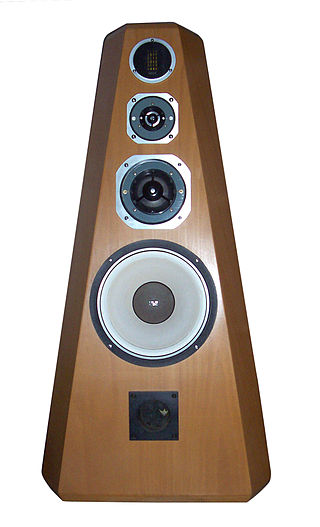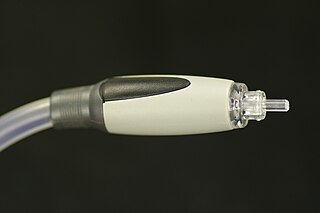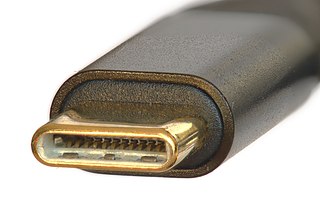Related Research Articles

High fidelity is the high-quality reproduction of sound. It is popular with audiophiles and home audio enthusiasts. Ideally, high-fidelity equipment has inaudible noise and distortion, and a flat frequency response within the human hearing range.

Universal Serial Bus (USB) is an industry standard that allows data exchange and delivery of power between many various types of electronics. It specifies its architecture, in particular its physical interface, and communication protocols for data transfer and power delivery to and from hosts, such as personal computers, to and from peripheral devices, e.g. displays, keyboards, and mass storage devices, and to and from intermediate hubs, which multiply the number of a host's ports.

An audio power amplifier amplifies low-power electronic audio signals, such as the signal from a radio receiver or an electric guitar pickup, to a level that is high enough for driving loudspeakers or headphones. Audio power amplifiers are found in all manner of sound systems including sound reinforcement, public address, home audio systems and musical instrument amplifiers like guitar amplifiers. It is the final electronic stage in a typical audio playback chain before the signal is sent to the loudspeakers.

High-Definition Multimedia Interface (HDMI) is a proprietary audio/video interface for transmitting uncompressed video data and compressed or uncompressed digital audio data from an HDMI-compliant source device, such as a display controller, to a compatible computer monitor, video projector, digital television, or digital audio device. HDMI is a digital replacement for analog video standards.
Amphenol Corporation is a major producer of electronic and fiber optic connectors, cable and interconnect systems such as coaxial cables. Amphenol is a portmanteau from the corporation's original name, American Phenolic Corp.

DisplayPort (DP) is a digital display interface developed by a consortium of PC and chip manufacturers and standardized by the Video Electronics Standards Association (VESA). It is primarily used to connect a video source to a display device such as a computer monitor. It can also carry audio, USB, and other forms of data.

Monster Inc. is an American company that manufactures and markets about 6,000 products, but is best known for audio and video cables. It also produces speakers, headphones, power strips, mobile accessories and audio devices for automobiles. The company was founded by an audiophile and engineer, Noel Lee, in 1979 by experimenting with different ways to build audio cables. It grew by doing demonstrations to convince the industry that audio cables made a difference in audio quality and by establishing relationships with retailers that were attracted to the cable's profit margins.

A video sender is a device for transmitting domestic audio and video signals wirelessly from one location to another. It is most commonly used for sending the output of a source device, such as a satellite television decoder, to a television in another part of a property and provides an alternative to cable installations.
Luxman is a brand name of Japanese Luxman Corporation (ラックスマン株式会社) that manufactures luxury audio components. Luxman produces a variety of high-end audio products, including turntables, amplifiers, receivers, tape decks, CD players and speakers.

Belkin International, Inc., is an American consumer electronics and networking company headquartered in El Segundo, California. It produces mobile and computer connectivity devices and peripherals for consumer and commercial use. These include wireless chargers, power banks, charging cables, data cables, audio and video adapters, headphones, earbuds, smart speakers, screen protectors, surge protectors, Wi-Fi routers, smart home products, electronic device sanitizers, docking stations and data hubs, network switches, KVM switches and network cables.
Mobile High-Definition Link (MHL) is an industry standard for a mobile audio/video interface that allows the connection of smartphones, tablets, and other portable consumer electronics devices to high-definition televisions (HDTVs), audio receivers, and projectors. The standard was designed to share existing mobile device connectors, such as Micro-USB, and avoid the need to add video connectors on devices with limited space for them.
Wireless HDMI is the wireless transmission of high-definition audio and video signals between devices, using unlicensed radio frequencies like 5 GHz, 60 GHz, or 190 GHz. This technology eliminates the need for an HDMI cable, allowing users to transmit signals wirelessly between the component device and the display device. Wireless HDMI converts the HDMI cable signal into a radio frequency which is broadcast across the wireless spectrum. This allows for video source and display device to be in different rooms, without the need for cables. The technology emerged in the early 2000s.
Audio connectors and video connectors are electrical or optical connectors for carrying audio or video signals. Audio interfaces or video interfaces define physical parameters and interpretation of signals. For digital audio and digital video, this can be thought of as defining the physical layer, data link layer, and most or all of the application layer. For analog audio and analog video these functions are all represented in a single signal specification like NTSC or the direct speaker-driving signal of analog audio.

IPtronics was a fabless semiconductor company headquartered in Copenhagen, Denmark. Its products include integrated circuits for parallel optical interconnect applications intended for the computer, storage and communication industries. IPtronics' design center is certified by STMicroelectronics, which is also their semiconductor foundry partner. In June 2013, IPtronics was acquired by Mellanox Technologies.

TOSLINK is a standardized optical fiber connector system. Also known generically as optical audio, its most common use is in consumer audio equipment, where it carries a digital audio stream from components such as CD and DVD players, Digital Audio Tape recorders, computers, and modern video game consoles, to an AV receiver that can decode two channels of uncompressed pulse-code modulated (PCM) audio or compressed 5.1/7.1 surround sound such as Dolby Digital or DTS Surround System. Unlike HDMI, TOSLINK does not have the bandwidth to carry the uncompressed versions of Dolby TrueHD, DTS-HD Master Audio, or more than two channels of PCM audio.
Miracast is a wireless communications standard created by the Wi-Fi Alliance which is designed to transmit video and sound directly from devices to display receivers. It can roughly be described as "HDMI over Wi-Fi", replacing cables in favor of wireless. The protocol is utilised in many devices and is used or branded under various names by different manufacturers, including Smart View and AllShare Cast, SmartShare, screen mirroring, Cast, wireless display and screen casting.

USB-C, or USB Type-C, is a 24-pin connector that supersedes previous USB connectors and can carry audio, video and other data, e.g., to drive multiple displays, to store a backup to an external drive. It can also provide and receive power, such as powering a laptop or a mobile phone. It is applied not only by USB technology, but also by other protocols, including Thunderbolt, PCIe, HDMI, DisplayPort, and others. It is extensible to support future standards.
AudioQuest is a company that was founded in 1980 by William E. Low and provides audio/video cables, digital-to-analog converters, headphones, power-conditioning products, and various audio/video accessories. The company is based in Irvine, California, has offices in the Netherlands and distributes its products to approximately 65 countries throughout the world.
References
- ↑ "An Interview With Joe Reynolds Of Nordost Corporation Interview By Phil Gold". www.enjoythemusic.com. Retrieved 2016-06-10.
- ↑ "Nordost Heimdall 2 Headphone Cable - The Audio Beat - www.TheAudioBeat.com". www.theaudiobeat.com. Retrieved 2016-06-10.
- ↑ "Nordost Odin 2 cables". Hi-Fi+. Retrieved 2016-06-10.
- ↑ Sa, George de (2014-12-04). "Upgrading an Audio System With Nordost Norse 2 Heimdall 2 Cables". CANADA HiFi Magazine. Retrieved 2016-06-10.
- ↑ "Nordost Releases First American Made High Speed HDMI Cable". The Absolute Sound. Retrieved 2023-08-07.